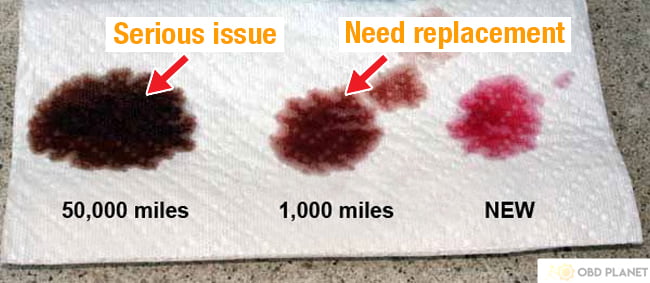Does your car start fine as you switch the ignition on, but throttles and stalls when put in drive or reverse?
If so, you can take a sigh of relief because you’re not the only one. This is a common problem that persists among car owners and could be due to transmission fluid leaks, a broken torque converter, blocked idle control valve, and more.
So, please read our article where we will try to help you understand:
- What problems your car is having
- What you can do to fix it
- And the most important question – How much will it cost to repair?

Check transmission fluid
Transmission fluid is responsible for keeping a vehicle’s transmission (automatic or manual) lubricated. Not only that, but it also ensures that the car’s transmission is kept cool throughout its use.
If your vehicle is stalling when in drive or reverse, it could be because of one of the two things. Either your vehicle is running low on transmission fluid (due to leaks) or you could possibly have bad transmission fluid.
Signs to look for
There are certain signs to help determine if something is wrong with your transmission fluid, and they are:
- Gears slipping out.
- Difficulty in shifting gears.
- Slow gear shifts.
Checking the transmission fluid is really simple.
First, warm up your vehicle’s engine and keep your car idling on a flat surface.
Remove the dipstick, wipe it down with a clean cloth, and slowly re-insert the dipstick. Once inside, take it out again and examine the dipstick, which will tell you two things:
- The level of the transmission fluid
- Whether or not the fluid is bad.
The level can be measured against the markings on the dipstick, and you can determine if the fluid is bad from its color. Healthy fluid is pinkish-red in color, while brownish-red or darker should start ringing alarm bells that the fluid needs replacing or there is a more serious issue.
How to fix

If there is a leak
Transmission fluid does not dry or evaporate like water, so if you’re running low on transmission fluids, then there is likely a leak that is causing this. Leakages can often be traced back to cracked pan gaskets.
Previous transmission fluid changes could result in loose bolts which need to be tightened. Therefore, before you replace the pan gasket, check if the bolts are tightened on it.
However, if the bolts are tight, there could be a crack in the gasket, requiring replacement.
To replace the pan gasket, you might need to remove a couple of items before reaching the gasket. Read the instructions on your car’s manual to get vehicle-specific procedures. If you’re willing to get your hands a little dirty, you can replace the pan gasket at home by yourself and save some money. Here’s how:
For small leak, you can just use transmission stop leak fluid. This will seal the small leak and can be used by both automatic and manual transmission vehicles. Below are two great options worth trying out if you have a minor leak:


If the transmission fluid color is not good

If you’re getting a dark-colored liquid upon taking the dipstick out, you need to replace the transmission fluid. It can easily be done at home!
How to change automatic transmission fluid:
How to change manual transmission fluid:
How much does it cost?
Fixing transmission leaks
Pan gaskets are relatively inexpensive items and can be found at any local mechanic, or online. Buying a pan gasket can set you back between $20 to $45, depending on the type of pan gasket, its quality, and the brand.
Getting your mechanic to replace your gasket will add labor costs to it, which can send the price upwards of $150.
However, before you consider splurging on replacing a gasket, you can purchase transmission stop leak fluid for around $10 to $12 and sort out minor leaks from wear and tear.
Replacing transmission fluid
If you’re looking to replace the fluid, heading over to the mechanic can set you back $80 to $150. However, you can do this yourself at home for about $40 to $90. That’s almost half of what a mechanic would charge. This cost includes a new gasket and transmission fluid.
Changing the filters would cost you an extra $15 to $30 so definitely worth considering doing it yourself to save a bit of cash.
Torque converter
Torque converters (only in automatic transmission vehicles) need transmission fluid to deliver power to the engines and shift transmission gears, ensuring that the vehicle runs smoothly.
If you have a damaged or broken torque converter, it will also cause your engine to turn off.
Signs to look for
When you’re driving your vehicle, see if you’re have any of the issues mentioned below. These issues are signs of a failing torque converter and can damage your vehicle if it’s not fixed immediately.
- Slipping out of gear.
- Weird noises like humming, whirring.
- Check your engine temperature signs for overheating.
How to fix
The best way to fix this problem is by replacing the torque converter in your vehicle. If you have fixed a torque converter before or have an experienced friend or family member to help you out, then we recommend buying a torque converter online or from a local shop.
However, if you don’t have any DIY experience with torque converters or don’t know anyone to lend you a helping hand, we recommend getting a mechanic to look into it. Torque converters are very complicated, and you could further damage your vehicle if you don’t have any experience with this.
How much does it cost?
You can find torque converters in the range of $100 to $600, obviously depending on the make and model of your vehicle etc.
Going to an expert to have your torque converter replaced can cost you between $500 to $1,000.
Clutch
In a manual transmission car, the clutch is responsible for providing power from the engine to the shafts that turn the wheels.
If your vehicle stalls when in drive or reverse, this could perhaps be due to a failing clutch disc. The inner lining on these discs can wear out due to usage and restrict power from the engine to the transmission.
Signs to look for
You need to look out for the following signs to determine whether it is a bad clutch that is causing the vehicle to stall:
- A soft clutch.
- Difficult to shift gears.
- Your vehicle slips out of gear while driving.
- Burning smell due to friction from the clutch slipping.
- Irregular noises.
How to fix
You can replace a failing clutch at home, but you need to have some experience and it is not a repair that I would suggest newbies try to tackle on their own. It can also be very time-consuming as you would need to remove a couple of parts before you can reach the clutch. Here how you can do it:
How much does it cost?
The clutch disc itself will cost you around $500 to $700, while labor charges can be between $450 to $600 (obviously depending on vehicle make, model etc.).
Idle air control valve
The idle air control valve is responsible for controlling the engine’s idle speed. The valve is also responsible for regulating airflow into the engine to keep it cool when needed.
If you’re driving or in reverse and your car shuts off, this could be because the idle air control valve is blocked or shut. A blocked idle air control valve restricts airflow to the engine, causing the engine not to burn fuel and eventually shuts off.
Signs to look for
Here are the signs that you should look out for if your vehicle is stalling when put in drive due to a faulty or clogged idle air control valve.
- Struggling when starting up
- Making stuttering sounds while idling
- Starting but then immediately turns off
- Backfiring
- Check engine light is on
- Stalling under load
How to fix
Since your vehicle’s idle air control valve restricts airflow, cleaning the valve can help solve the problem.
Clean idle air control valve
The best way to clean the idle air control valve is to get hold of the aerosol throttle cleaner and follow the instructions below:

Replacing the idle air control valve
After cleaning the idle air control valve, if the idle speed still surges, you’ve got yourself a defective valve that needs replacing.
Here’s how you can replace the idle air control valve.
How much does it cost?
Replacing the idle air control valve
Typically, the idle air control valve will cost you around $20 to $100, depending on your vehicle’s make and model.
Add $50 to $100 in labor charges if you’re heading over to a mechanic to do it for you.
Cleaning the idle air control valve
For the cleaning bit, you can buy an aerosol throttle cleaner for around 10 to 15 bucks.
Vacuum leaks
Engine vacuum is responsible for mixing in air and fuel to create the right balance of mixture for the engine to burn and create power.
If your vehicle is shutting off when put in drive or reverse, you may have too much air into the engine. With the wrong combination of the two, the engine starts to become inefficient and eventually shut off while driving.
Signs to look for
- The check engine light is on.
- There is a case of rough idling or even surging.
- Your engine makes a hissing sound.
How to fix
This is a bit tricky as there is no particular part that can be fixed to ensure proper engine vacuum.
To check for engine vacuum leaks, examine the following vehicle parts for any wear and tear or leaks:
- Intake snorkel
- Intake gaskets
- Vacuum hoes
- PCV system
- EGR valve
You can buy a spray carburetor cleaner to try find where the leaks are. This video will show you how to do it.

How much does it cost?
For most of the parts that require replacing to fix engine vacuum leaks, we recommend approaching a mechanic to do it for you. This is because it requires removing the intake manifold, which can be complicated and take a lot of time, even for experts.
Intake snorkel
- $25 to $65 for an intake snorkel
- You can replace this at home and save yourself some money
Intake gaskets
- $20 to $60 for a gasket
- You should let the mechanic do this as it requires removing the intake manifold. Labor charges are usually around $150 to $450
Vacuum hoses
- $10 to $30 depending on the quality of the hose
- You can easily replace this at home.
PCV system
- The PCV hose costs between $35 to $75
- PCV system parts cost between $10 to $15
- Labor charges can be $25 to $60
EGR valve
- $70 to $490 for replacement parts
- Labor charges should be around $60 to $70
Conclusion
It can get difficult to troubleshoot the exact problem that your vehicle is having. Unlike humans, vehicles can not talk. However, you can get scanning devices that will give you a better idea of what may be wrong, but most of the time, you’ll be on the lookout for signs of possible problems. Troubleshooting and taking it one step at a time is the way to go if you’re looking to DIY.
Mechanics are car experts and can tell from experience what the problem is. But then again, labor charges can get quite high if it involves complicated removals such as the intake manifold. So we recommend, wherever possible, trying to do smaller things yourself, while leaving the complicated stuff for the experts.


